With a population of just over one million people, Saskatchewan is the smallest mainland province in Canada. Saskatoon, the most populous city, has just over 260,000 residents, and the capital of Regina sits just behind it at 215,000. No other city has a population of over 50,000.
However, when it comes to hockey, the small province is number one. Saskatchewan has produced the most NHL players per capita in Canada since the 1950s; in 2017, it had 2.1 players per 100,000 residents but has been as high as 3.6. The high volume of talented players has created a rich history with hockey, starting way back in the early days of the NHL, and encompasses people from the largest urban centers to the smallest rural communities.
G – Glenn Hall
Hailing from Humbolt, Glenn Hall made his NHL debut with the Detroit Red Wings in 1952-53, playing six games over the course of the season and recording four wins. The 21-year-old showed promise, but the Red Wings already had their star in net with Terry Sawchuk, and in that era, teams rarely used their backups unless absolutely necessary. So Hall was forced to sit and wait for his chance to play regular minutes in the NHL.
That day finally came in 1955-56, when Sawchuk joined the Toronto Maple Leafs, leaving Hall as Detroit’s top goalie. He ended up playing all 70 games as a rookie, posting a 30-24-16 record and recording an incredible 12 shutouts, the highest total in the league. He was the easy choice for the Calder Trophy, as well as a second All-Star team selection.
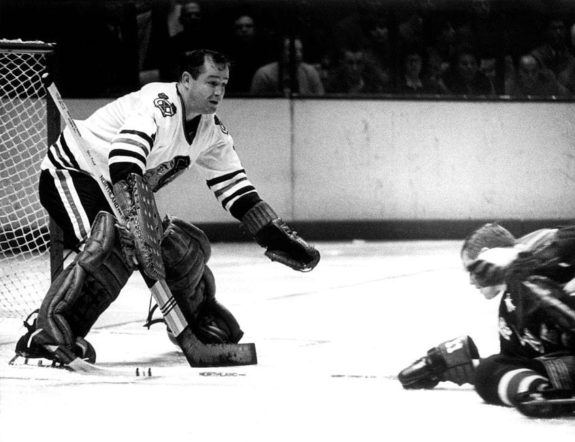
But Hall was just getting started. Until 1962-63, he didn’t miss a game, setting an unbeatable record of 502 consecutive appearances in net, plus 50 playoff games. During that run, he was traded to the Chicago Blackhawks in 1957-58 and won his only Stanley Cup in 1960-61, was selected to the All-Star team five times, lead the league in wins once, and led the league in shutouts three times. It’s a record that will never be broken; even among his contemporaries, he’s head and shoulders above the next longest streak. He later won the Vezina Trophy in 1962-63, 1966-67, and 1968-69 and was selected to the All-Star team five more times before he retired.
“You have to be lucky to have a run like I had, and I was. Of course, you have to be a little bit crazy to play where I played, and I plead guilty on that count too.”
Glenn Hall
Despite being the best goalie in the NHL of the decade, Hall still found himself on the expansion, St. Louis Blues in 1967. An unenviable task for even the biggest stars, he made the most of it, and at the age of 36, he captured his first Conn Smythe Trophy as the NHL’s playoff MVP, despite getting swept in the Stanley Cup Final by the Montreal Canadiens. He played three more seasons, leading the league in shutouts in 1968-69, and finally retired in 1971, and was inducted into the Hall of Fame in 1976. He was dubbed “Mr. Goalie” for his consistent dominance and is also credited for innovating the butterfly stance, which most goalies utilize to this day.
D – Eddie Shore
There is a good argument that Eddie Shore was the toughest hockey player to ever play the game.
Born in 1902 – three years before Saskatchewan became an official province – Shore grew up in Cupar, a small town in the Fort Qu’Appelle river valley just north of Regina. He was more concerned with his family’s ranch than hockey; his older brother, Aubrey, was the real athlete of the family. He began to take the sport more seriously as a teenager, and in 1924-25, at the age of 22, he signed his first hockey contract with the Western Canada Hockey League. However, the WCHL folded after the 1925-26 season, and his rights were sold to the brand-new Boston Bruins of the NHL.
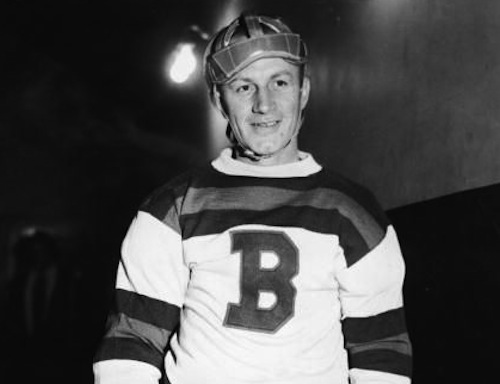
Despite playing as a forward for most of his career, he began playing defense in 1925-26, and it proved to be the best decision of his career. In his first season, Shore led the Bruins with 130 penalty minutes, almost 50 more than the next highest total, while also leading in defensive scoring with 12 goals and 18 points. No one else played like him: fast, skilled, and tough as nails. He was repeatedly bloodied during games, and required dozens of stitches over his career; some accounts say that he had over 1000 on his face alone. But it never took away from his skill, and in 1929, he helped the Bruins win their very first Stanley Cup.
“He was the only player I ever saw who had the whole arena standing every time he rushed down the ice. He would either end up bashing somebody, get into a fight or score a goal.”
Hammy Moore, long-time Bruins’ trainer
Over his 15-year career, Shore regularly led all defensemen in goals and points, was an eight-time All-Star, and won the Hart Trophy as the NHL’s most valuable player in 1933, 1935, 1936, and 1938, and helped the Bruins win another Cup in 1939. He left the NHL in 1940 after a brief stint with the New York Americans and was inducted into the Hall of Fame in 1948. Some have called him the Babe Ruth and Ty Cobb of hockey as he revolutionized the sport, and his impact on hockey in the United States helped grow the game like no one before him.
D – Brad McCrimmon
Saskatchewan has produced plenty of hard-nosed defensemen over the years, possibly due to many of them coming from small towns and farms, where they learned how to work before learning hockey. Such was the case for Brad McCrimmon, who grew up in the small village of Plenty, southwest of Saskatoon, and became one of the best leaders of the 1980s and 1990s and the quintessential clutch player.
McCrimmon broke into the NHL with the Bruins in 1979-80, just months after leading the Brandon Wheat Kings to a WHL Championship and getting picked 15th overall. He started as primarily a defensive defender, but after getting traded to the Philadelphia Flyers in 1982, he developed into a more all-around presence, attacking the puck more often but still playing strong defensive hockey. With the Flyers, he became a top producer, but contract issues caused him to wear out his welcome in the City of Brotherly Love. The Calgary Flames, looking for a stabilizing presence on defense in order to make a deep playoff run, decided to take a chance and signed him in 1987-88.
In his first season with the team, McCrimmon recorded the highest plus-minus stat in the league with a plus-48 and earned his first – and only – All-Star nomination. In his second season, he was instrumental in helping the Flames win their very first Stanley Cup, playing all 22 games and chipping in three assists; in his third, he was named the franchise’s 10th captain, taking over for the legendary Lanny McDonald. McCrimmon was arguably was the only choice to fill such big shoes in Calgary, as he was universally loved by his teammates for his willingness to do anything for the team. It earned him his intimidating nickname, “The Beast.”
Gruff. Tough. And if you look at some of those photos, cuts on his nose, teeth missing. But he couldn’t wait to go back to war for Game 1, Game 2, Game 3 …The tougher it got, the more he showed up, the better he got.”
Lanny McDonald
McCrimmon retired in 1997 and immediately got into coaching. Sadly, that part of his career was cut short when, after taking a job with Locomotiv Yaroslavl in the KHL, the team’s plane went down, killing him and nearly everyone on board. He played with some of the league’s best defensemen over his 18-season career, from Ray Bourque and Mark Howe to Gary Suter and Nicklas Lidstrom, and he could keep up with all of them. Brian Propp, a fellow Saskatchewan-born star for the Philadelphia Flyers, claimed he was one of the most underrated defensemen of all time. (from ‘Is Brad McCrimmon Hall of Fame worthy?,’ Philadelphia Inquirer, 09/08/2011)
C – Bryan Trottier
Bryan Trottier never set out to be the best. He wasn’t the biggest or strongest, but always worked hard and tried to be exactly what his team needed. He learned how to play hockey on his ranch south of Val Marie, a tiny village in the very most southern part of the province when his dad flooded some flat land by breaking beaver dams on Frenchman Creek. But his skill was evident from the start. In 1974-75, he won the WHL’s Player of the Year Award after amassing 144 points with the Lethbridge Broncos. The New York Islanders used their second-round pick that summer to select him, and the following season, he won the Calder Trophy after scoring 32 goals and 95 points.
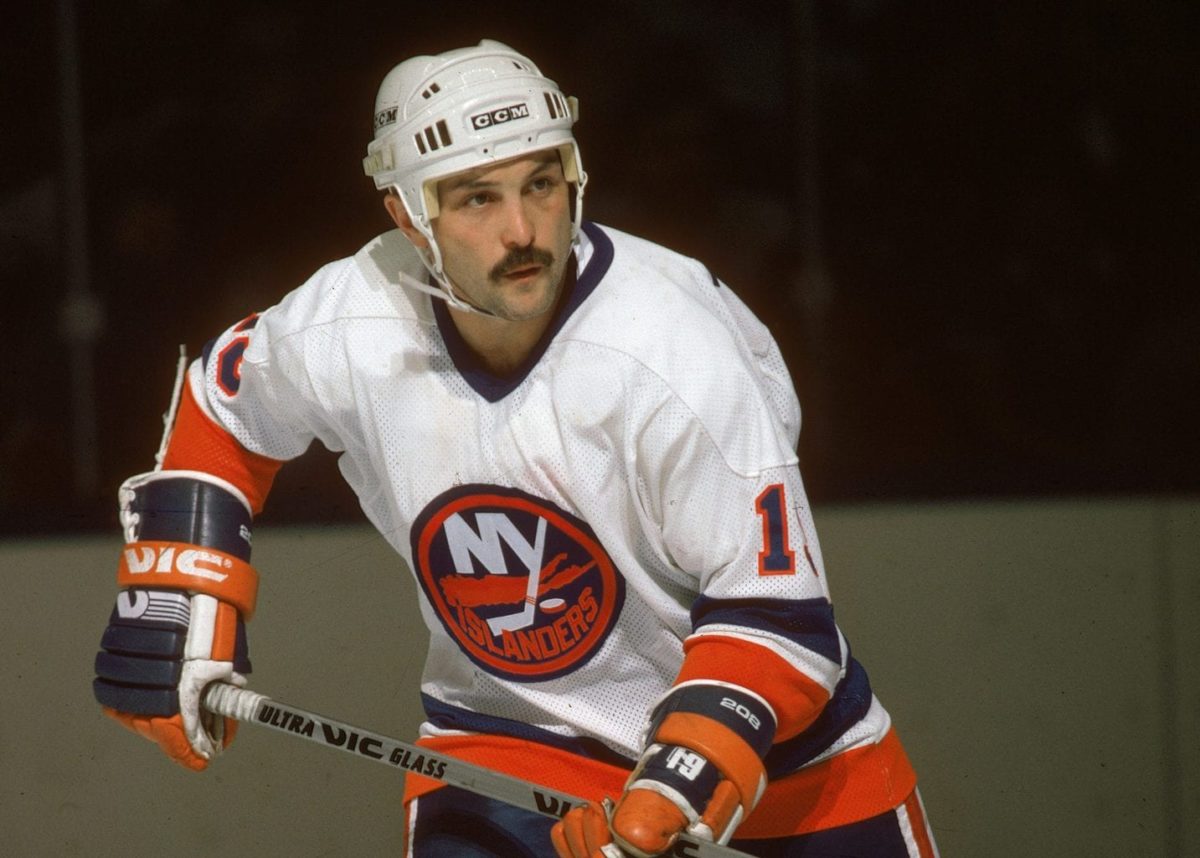
From then on, Trottier racked up the awards. He was selected as an All-Star nine times, won four Stanley Cups with the Islanders, claiming the Conn Smythe Trophy in 1980, plus two more Cups with the Pittsburgh Penguins. He also won the Art Ross Trophy as the league’s top scorer and the Hart Trophy in 1979, the King Clancy Award for leadership and humanitarian efforts in 1989, led the NHL in assists and playoff points twice in different seasons. And, if being a dynamic offensive forward wasn’t enough, he was also a respected leader, wearing the ‘A’ for the Islanders from 1986 to 1990, then with the Penguins from 1992-94.
“Right from the start, I just wanted to contribute somehow, whether it was by bumping somebody, making a pass or scoring a goal…I liked to earn my pay every day.”
Bryan Trottier
Trottier retired in 1994, and like many stars, turned to coaching, standing behind the bench of the Cup-winning Colorado Avalanche in 2001 and serving as the director of player personal for the Islanders from 2006-10. He was inducted into the Hall of Fame in 1997, an easy first-ballot choice. But despite his success, Trottier remained humble throughout his career. He never forgot his humble beginnings of playing hockey with his dad on the frozen Frenchman Creek in the southernmost part of Saskatchewan.
LW – Wendel Clark
He may not have won a Stanley Cup, nor claimed an individual award, but Wendel Clark was one of the fiercest competitors in the NHL from 1985 until his retirement in 2000. Raised in the small town of Kelvington, located two and a half hours east of Saskatoon, he began playing hockey as a defenseman. His toughness and high-offense style made him a star with the Saskatoon Blades and also earned him a spot on Canada’s World Junior roster in 1985, where he scored three goals and five points en route to winning the gold. The combination of leadership, grit, and skill was too good for the Maple Leafs to ignore, and so they used their pick to make him the first overall selection in the 1985 draft.
But with Gary Nylund, Todd Gill, and Jim Benning on the blue line already, the Maple Leafs decided that they didn’t actually need another defenseman, so they moved Clark up to the left-wing. A strange move, it paid off instantly – Clark scored 34 goals as a rookie, while adding 227 penalty minutes, leading the team in both categories, and was named to the All-Sar game. The Maple Leafs were so impressed, they made him an alternate captain at just 20 years old. He responded by scoring 37 goals and putting up 271 penalty minutes, while adding another 11 points in 13 playoff games.
Over the next seven seasons, Clark established himself as the Leafs’ biggest star. He was named captain in 1991-92 and helped set a team record with 44 wins and 99 points in 1992-93, very nearly making it to the Stanley Cup Final for the first time since 1967, but were defeated by the Los Angeles Kings in a tough seven-game series. He helped them return to the Conference Final in 1993-94, scoring a career-high 47 goals, but were sent home early by the Vancouver Canucks in five games. Fans began calling him “Captain Crunch” because of his innate leadership skills and penchant for laying bone-crushing hits.
With his value at its peak, Clark was traded twice over the next two seasons, but he returned in 1996. However, the Maple Leafs were a very different team, and he failed to propel them into the postseason. He then signed with the Tampa Bay Lightning in 1998-99, where he scored 28 goals and 42 points in 65 games and earned his second All-Star Game appearance. With injuries and age catching up to him, he retired in 2000, but not before returning to the Maple Leafs one last time, playing his final 20 games with the team where he started. He finished with 330 goals, 564 points, and 1690 penalty minutes in 793 games, and his ’17’ was retired by Toronto in 2016.
RW – Gordie Howe
From Mr. Goalie to Mr. Hockey himself. Gordie Howe is regarded as one of the greatest hockey players of all time, sharing the mantle with the likes of Wayne Gretzky, Mario Lemieux, and Bobby Orr. His 1767-game, 26-season career spanned five decades, a record that will likely never be broken. Nor will his feat of playing until the age of 52. And it all started in small-town Saskatchewan with a very unassuming kid.
Howe was born in the small farming community of Floral but moved to Saskatoon when he was still very young. There he learned to play hockey, and at the age of 15, tried out for the New York Rangers in Winnipeg, as was the custom before the NHL implemented the entry draft. However, homesickness got the better of him, and the Rangers decided to pass on the teenager. The next season, the Red Wings decided to give him a shot and signed him to his first professional contract.
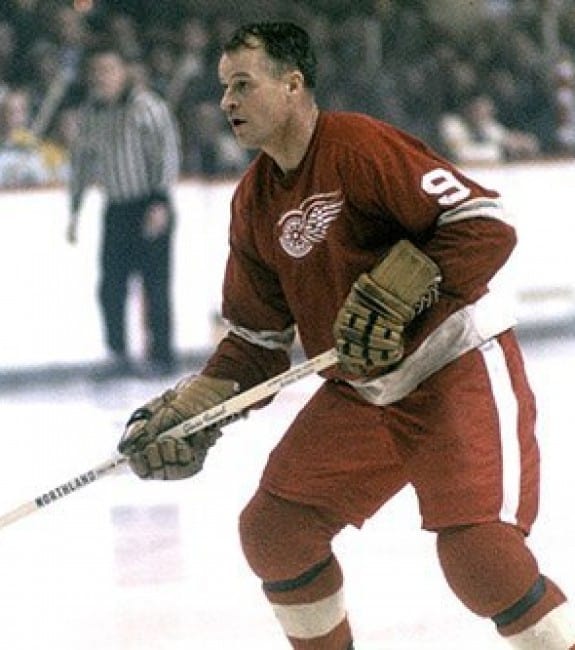
He made his Red Wings’ debut in 1946 at 18 years old, scoring seven goals and 22 points, fairly average offensive totals. But what wasn’t average was his toughness. Opponents knew very early not to mess with Howe; years of working with his father in construction had given him a tireless work ethic and incredible strength. They also learned that he was an expert at bending the rules, using his stick to hook, slash, and even lift players off the ice. But try to do it back to him, and according to Jean Beliveau, it was “akin to wrestling with a telephone pole.”
During his nearly three decades with the Red Wings, no one was more dominant than Howe. He claimed the Maurice Richard Trophy as the NHL’s goal leader five times, won the Art Ross and Hart Trophies six times each, and held the Stanley Cup over his head four times. He was also in the top-five in league scoring for 20 consecutive seasons, scored at least 23 goals in 23 consecutive seasons, and was an NHL All-Star 23 times. As Detroit began to struggle and enter into a rebuild, he decided that, in 1971, it was time to retire.
That was until his sons, Mark and Marty, joined the Houston Aeros in 1973-74. Although he had been inducted into the Hall of Fame in 1973, Howe saw a rare opportunity to play with his boys, and so he came out of retirement and joined the World Hockey Association, becoming one of the few active Hall of Famers. Despite being 45 years old, he was still one of the best players on the ice, leading the Aeros with 100 points, and the WHA awarded him the Gordie Howe Award as the league’s MVP, likely the only time a player has won the award named after them.
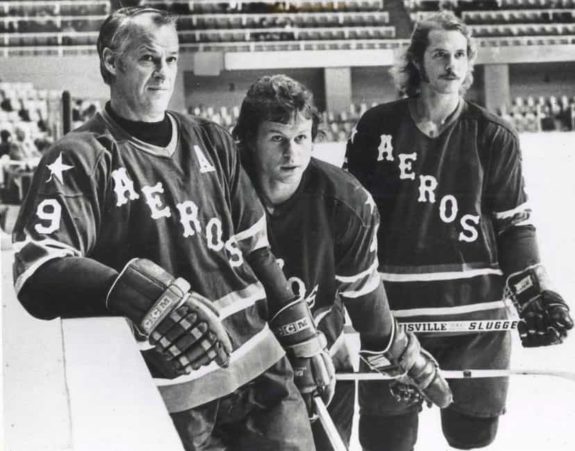
Howe continued to play for the next six seasons, finally retiring for good with the Hartford Whalers in 1980, but his impact on the game far outlasted his long career. His number ‘9’ has been retired by four separate clubs: the Red Wings, the Whalers, the Aeros, and, when the Whalers relocated, the Carolina Hurricanes kept the retired number in their rafters. He was idolized by both Orr and Gretzky, among countless other players, and always took time to sign an autograph or greet a fan. When he passed away in 2016 at the age of 88, he was remembered as a player who never believed he was the best but never stopped trying to get there.
A Long History of Success
It would have been easy to make a full roster of Saskatchewan-born players. Johnny Bower, Wade Redden, Ron Greschner, Keith Magnusson, Max Bentley, Patrick Marleau, Bernie Federko, Theoren Fleury, Clark Gillies…the list reads like a whos-who of hockey’s biggest stars from decades past. The number of All-Star caliber players is truly mind-boggling, especially considering the population of the province. It continues to produce top talent, too, and players like Brayden Holtby, Jaden Schwartz, Matthew Dumba, Haydn Fleury, and Ethan Bear making their mark on the league, and many more coming up looking to earn their spot in history.
Hockey is much more than a pastime in Saskatchewan – it’s a tradition. The mentality was summed up beautifully by Clark during his induction to the Saskatchewan Sports Hall of Fame, stating, “If you look around the hall of fame and you look at all the names, they all weren’t from the big cities of Saskatoon and Regina. There are little towns from all over the province where people got to be very good at what they were good at…It doesn’t matter where you’re from. If you put the time and effort in and you have some skill, you can make it.” (from ‘Wendel Clark honoured by the call to the Saskatchewan Sports Hall of Fame’, The Chronicle Herald – 09/05/2019).